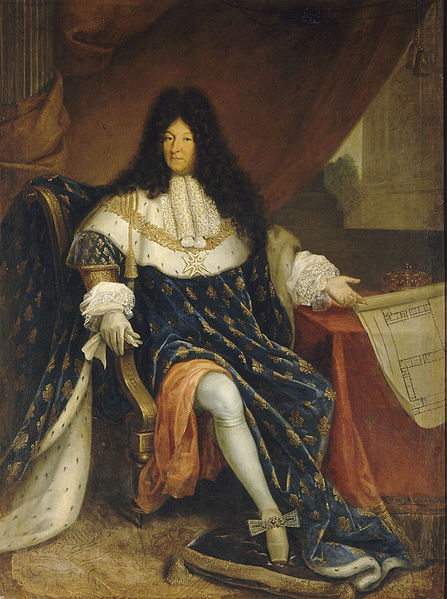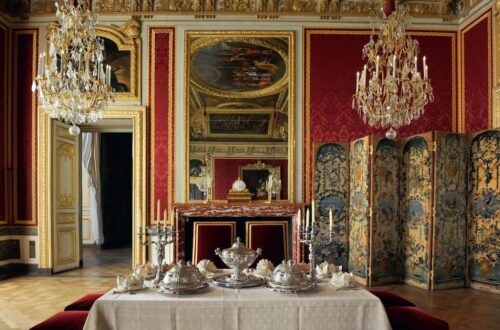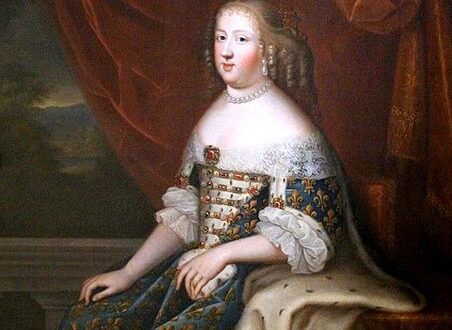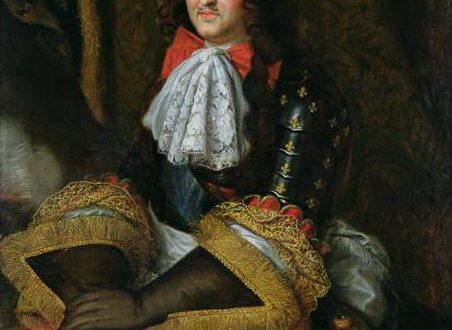The Grand Lever of the King
If you are Louis XIV, you can’t simply get up in the same way like the peasant down the road or the Vicomte in the chambers above you. Non, your awakening needs to have style and be of grand proportions, just like everything else. It needs to be of a dimension big enough to remind everyone of the fact that one is King, and not just a someone, as soon as one opens one’s eyes… and so Louis XIV turned something that has been around for quite a while already into a form of art, like so many other things.

The Lever, by itself, was nothing new. In the Life of Charlemagne, Einhard (775-840) recounts the Emperor’s practice, when he was dressing and putting on his shoes, to invite his friends to come in, and in case of a dispute brought to his attention, “he would order the disputants to be brought in there and then, hear the case as if he were sitting in tribunal and pronounce a judgement.” By the second half of the sixteenth century, it had become a formal event, requiring invitation. In 1563 Catherine de’ Medici wrote in advice to her son to do as his father, Henri II, had done and uphold the practice of the lever. Catherine describes that Henri II allowed his subjects, from nobles to household servants, to come in while he dressed.
Louis XIV was woken at eight o’clock by his Premier valet de la Chambre du Roi, which himself slept in the state-bedroom behind the gilded balustrade that seperated the grand state-bed with its closed curtains in the alcove from the rest of the room. The curtains were lightly opened and the chief physician, the chief surgeon and Louis XIV’s childhood nurse, as long as she lived, entered. The nurse placed a soft kiss on the King’s brow and the chamberpot was taken away to be examined.
The King did not always sleep in his own bed or was already awake before his official awakening, sometimes he even went hunting beforehand, but always returned to his state-bed in time for the ceremony.
The curtains were closed and drawn once again at a quarter past eight as the Grand Chamberlain was called, bringing with him the nobles who had the privilege of the Grande Entrée, a privilege that could be purchased, subject to the King’s approval, but which was restricted in Louis’ time to the nobles, such as the Princes du Sang. The King remained in bed, in his nightshirt and a short wig. The Grand Chamberlain of France, or in his absence the Chief Gentleman of the Bedchamber, presented Holy Water to the King from a vase that stood at the head of the bed and the King’s morning clothes were laid out.
The Master of the Bedchamber and the First Servant, both high nobles, pulled the King’s nightshirt over his head, one grasping each sleeve. The Grand Chamberlain presented the day shirt, which, according to Saint-Simon, had been shaken out and sometimes changed, because the King perspired freely. This was a moment for any of those with the privilege of the Grande Entrée to have a swift private word with the king, which would have been carefully rehearsed beforehand to express a request as deferentially but in as few words as possible. It was the perfect chance to bring something to Louis XIV’s attention before anyone else had the chance to do so, and thus to bring the King on one side or the other if the matter involved a dispute. The King was given a missal, and the gentlemen retired into the adjoining chambre du conseil while there was a brief private prayer for the King.
When the King had them called back, now accompanied by those who had the lesser privilege of the Première Entrée, his process of dressing began: Louis preferred to dress himself “for he did almost everything himself, with address and grace”, Saint-Simon remarked. The King was handed a dressing-gown, and a mirror was held for him, for he had no toilet table like ordinary gentlemen. Every other day the King shaved himself. Now other privileged courtiers were admitted, a few at a time, at each stage, so that as the King was putting on his shoes and stockings “everyone”—in Saint-Simon’s view—was there.
This was the Entrée de la Chambre, which included the King’s readers and the director of the Menus Plaisirs, the part of the royal household in charge of all preparations for ceremonies, events and festivities.
During the Entrée de la Chambre, the Grand Aumônier and the Marshal of France and the king’s ministers and secretaries were admitted as well.
A fifth entrée followed and admitted Ladies for the first time, along with any visiting ambassadors and a sixth entrée admitted, from a privileged position at a cramped backdoor, the King’s children, legitimate and illegitimate indiscriminately, along with their spouses and the the Cardinals and Bishops.
The crowd in the chambre du Roi can be estimated from Saint-Simon’s remark of the King’s devotions, which followed: the King knelt at his bedside “where all the clergy present knelt, the cardinals without cushions, all the laity remaining standing”.
After the Master of the Wardrobe fastened the King’s jabot and the Lord of the Neckcloths adjusted it, the King then passed into the cabinet where all those who possessed any court office attended him. He then announced what he expected to do that day and was left alone with those among his favourites of the royal children born illegitimately, who he had publicly recognised and legitimated, and a few favourites.
The Petit Lever was finished with the Grand Lever, and the official start of a day at court, the entry of the King into the Grande Galerie, where the rest of the court awaited him in hopes the King might look at them, or perhaps even address them with a word or two.



